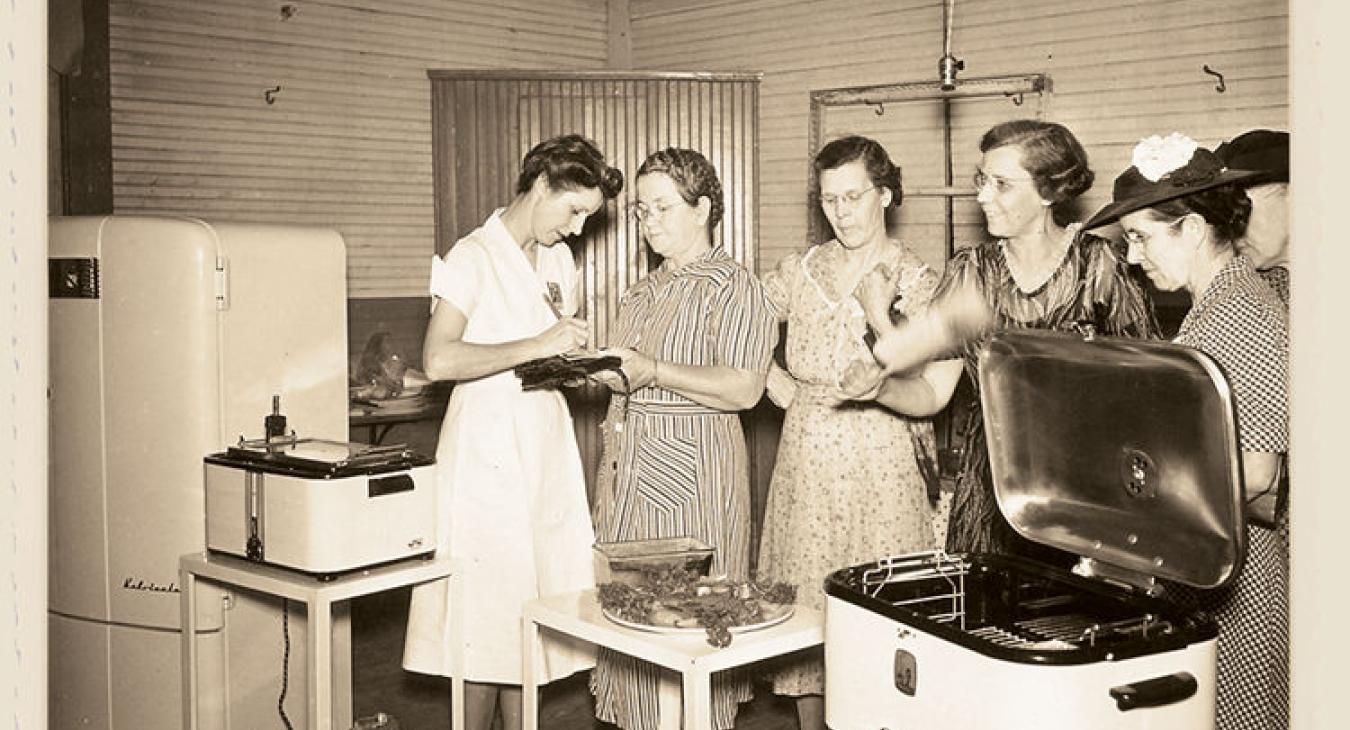Women gather at an appliance showcase in the Bluebonnet region in the mid-1940s. Appliance shows like this, put on by the federal Rural Electrification Administration, drew large crowds across the country. Join us at our Annual Meeting on May 14 in Giddings to see a lineup of vintage appliances, our large appliance timeline and other nods to our 80th anniversary. The event is open to all Bluebonnet members.
BY ED CROWELL
When Bluebonnet Electric Cooperative powered the first light bulbs in rural Central Texas in 1939, the World’s Fair in New York was unveiling an all-electric home with a dazzling kitchen, complete with a refrigerator, electric range, dishwasher, coffee maker, garbage disposal, food mixer and an automatic toaster.
To allow buyers in Texas and other states to get a close look at these life-changing devices, the federal Rural Electrification Administration outfitted a traveling show of circus tents filled with innovative home appliances. The caravan of dreams drew crowds by the thousands, and by the early 1940s, appliance sales were skyrocketing.
Wood-burning stoves, clothing washboards and heavy hand irons heated by a fire — all of which required backbreaking labor — were pushed aside for these conveniences of modern living.
The consumer race for electric appliances gained momentum as World War II ended in 1945. The post-war housing boom increased consumer demand for kitchen appliances as well as electric radios and then TVs.
By the 1950s, color televisions were available, though most popular TV shows aired in black-and-white until the late 1950s or early 1960s. General Electric made its household appliances pop by adding color such as Petal Pink and Canary Yellow (a design trend that may have influenced the future Apple CEO Steve Jobs in the late 1990s when he unveiled colorful “flavors” of the iMac personal desktop computer: blueberry, strawberry, lime, tangerine and grape).
At Bluebonnet’s then-headquarters in Giddings, electric appliances could be viewed and touched, just like in a retail showroom. Bluebonnet held appliance demonstrations in small towns and communities across its service area.
The 1960s and 1970s brought the ability to save substantial time on cooking. Microwaves, Crock-Pots and Mr. Coffee — the first automatic drip machine — were unveiled and embraced by consumers. Cuisinart food processors and hot-air popcorn poppers also made kitchen time less onerous.
Again, Bluebonnet took center stage to help consumers understand how all those new appliances could change lives. Bluebonnet hired Lavonne Morrow to demonstrate microwave cooking, and some events drew more than 100 eager learners. She shared recipes for microwave casseroles, three-minute fudge and even a tiny birthday cake baked in an ice cream cone. To consumers’ amazement, she showed how an entire meal for six people could be prepared and cooked in a microwave in just 30 to 45 minutes.
Clearly, electric appliances were changing American culture. The convenience of a microwave, washing machine or vacuum cleaner freed more time for work outside the home. Growing numbers of American women joined the workforce for a paycheck.
America turned its attention to the environment in the 1970s, as oil and gas supply crises brought long lines at the gas pumps and prompted President Jimmy Carter to ask Americans to save energy by turning thermostats to 65 or lower in the winter.
It’s no surprise that the 1980s and 1990s saw advances in energy efficiency in home appliances and a big turn toward automation. In 1992, the Environmental Protection Agency introduced the Energy Star program to promote the purchase of energy-efficient appliances.
Today’s digital age is bringing increasingly “smart” electronics into the home that merge internet connectivity with phones, computers, artificial intelligence devices and appliances. Alexa, the voice-activated virtual assistant in the Amazon Echo device, was unveiled in 2016, and 100 million had been sold by the end of 2018, according to the company. A seemingly endless stream of other new devices can connect with the Echo or its top competitor, Google Home. Virtual assistants can turn on and off smart appliances and timers, stream music and read books to you, and each adds new skills regularly. A glut of smart security cameras that allow you to view the outside or inside of your home on your phone are popping up everywhere.
In the living room, consumers are making way for big-screen televisions with curved displays, screens that roll up and down and technology that illuminates every pixel in the screen. That means viewers can sit at any angle to the screen without a distorted image.
Some of today’s refrigerators have cameras inside to show whether you need to buy milk or eggs when you check from a smartphone while at the grocery store. Samsung’s $4,100 fridge also has a computer screen on the outside door for searching recipes, displaying family photos and keeping lists and calendars. GE’s new Kitchen Hub is a smart screen on a stove ventilation hood. It controls the thermostat and lights, security cameras, and other smart appliances. Users can stream movies and music and have video chats.
Or, there is always the option to just ignore all of these chatty, mind-boggling innovations.
Today’s refrigerators are a long way from the Giddings High School “home ec” classes that Shirley Hannes began teaching in 1961. She commanded four kitchen nooks filled with stoves, refrigerators, washers and dryers, all loaned by Bluebonnet. Hannes made certain her students knew how to use the latest in home appliances, some of which must have glowed in mid-century hues of Harvest Gold and Avocado.
Hannes, who now lives south of Houston in Pearland, doesn’t want a virtual assistant like Alexa, but she loves the two-door refrigerator she bought in 2018 because it makes and dispenses ice.
She’s not one to replace appliances just to have the newest model. “We built our house in 1976, and the stove was new then,” she said. “It’s still in good shape, so I’m not planning to replace it yet.”





